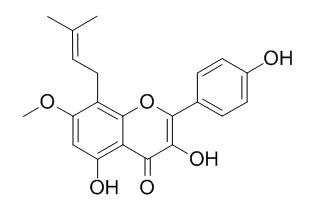Isoanhydroicaritin is a natural product from Epimedium brevicornu Maxim.
Providing storage is as stated on the product vial and the vial is kept tightly sealed, the product can be stored for up to
24 months(2-8C).
Wherever possible, you should prepare and use solutions on the same day. However, if you need to make up stock solutions in advance, we recommend that you store the solution as aliquots in tightly sealed vials at -20C. Generally, these will be useable for up to two weeks. Before use, and prior to opening the vial we recommend that you allow your product to equilibrate to room temperature for at least 1 hour.
Need more advice on solubility, usage and handling? Please email to: service@chemfaces.com
The packaging of the product may have turned upside down during transportation, resulting in the natural compounds adhering to the neck or cap of the vial. take the vial out of its packaging and gently shake to let the compounds fall to the bottom of the vial. for liquid products, centrifuge at 200-500 RPM to gather the liquid at the bottom of the vial. try to avoid loss or contamination during handling.
Chinese Pharmaceutical Journal, 2016 , 51 (24) :2169-2174
Isolation of antibacterial activity constituents of total flavonoids from sophora flavescens and simultaneous determination of seven flavonoids by HPLC[Reference:
WebLink]
To study the chemical constituents of the total flavonoids from Sophora flavescens and establish a method for simultaneous determination of seven compounds.
METHODS AND RESULTS:
The compounds were isolated by chromatography on silica gel and ODS column and their structures were elucidated by spectroscopic analysis. The samples were analyzed on a Dikma C18 column (4.6 mm × 250 mm, 5 μm) ; gradient elution was performed using mobile phase composed of methanol (A) and water (B); the detection was carried out using a photodiode array detector at 280 nm. Seven compounds were isolated and their structures were identified as kuratidine (1), sophoraflavanone G (2), kurarinone (3), Isoanhydroicaritin (4), isoxanthohumol (5), formononetin (6), and trifolirhizin (7). The calibration curve was linear within 8.70-87.00, 44.25-442.50, 128.10-1 281.00, 9.40-94.00, 48.40-484.00, 14.20-142.00, and 25.70-257.00 μg·mL⁻1 for kuraridine, sophoraflavanone G, kurarinone, Isoanhydroicaritin, isoxanthohumol, formononetin, and trifolirhizin, respectively (r > 0.999 0), and the extraction recoveries varied from 95% to 105%.
CONCLUSIONS:
The main chemical components contributing to antibacterial activity of total flavonoids may be sophoraflavanone G, kurarinone, and isoxanthohumol. The method is simple, rapid, accurate, and can be used simultaneously to determine the contents of the seven active ingredients.



